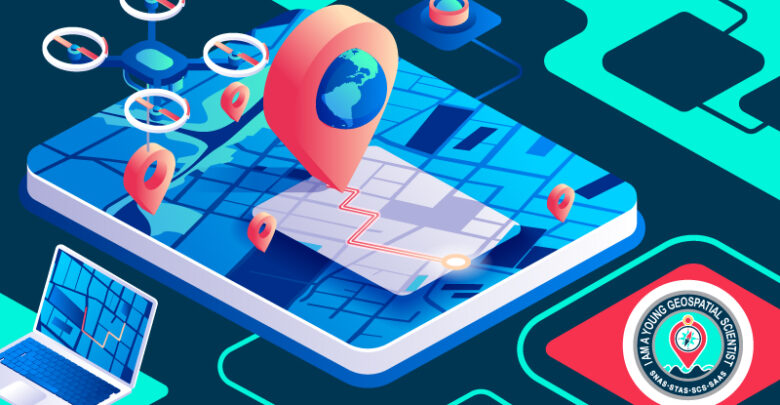Concept to CommercialisationEmerging Technologies
Geospatial Data and Mapping Guidelines

Meaning of Geospatial Data
Geospatial data may be understood as location intelligence that essentially utilizes location data to make informed decisions and efficient business solutions.[i] The term ‘geospatial’ has been traced to the early Cold War when it was believed that the US and Soviet governments were monopolising early developments of satellite-based surveillance technology.[ii] The system used to promote such decision-making as a multipurpose tool known as the Geographic Information System (GIS) that captures, stores, analyses, manages, and presents various geographical data. The data thus obtained is used by many present-day technologies with location intelligence. [iii]Such a system is said to be used for the first time during the 19th Century to plot cholera patients on a map of London. The John Hopkins tracker used to study and track the transmission of Covid-19 employed a GIS. It was further used to locate the nearest test centers and hospitals.[iv]
While these examples highlight the various advantages of geospatial data, it is also important to consider various security concerns that may arise. To further illustrate, reports have revealed that Palestine militants employed Google Earth’s satellite imagery to launch missiles on Israel. The terrorists captured during the horrific 26/11 Mumbai attacks conceded that they were shown specific locations to target using google maps. Thus, although the benefits of geospatial data are many, the issues surrounding it must be addressed. The following article seeks to further examine such advantages and disadvantages relating to the application of geospatial data systems. Subsequently, we shall delve into the need for mapping guidelines in this context.
Advantages of Geospatial Data
GIS is considered a tool that could be used to collect data and inform politicians, citizen groups, and government agencies on matters relating to suburban topology, segregation, and fiscal inequality. [v] Such information further allows for societal progress. For example, identifying the regions of fiscal equality would enable the relevant authorities (NGOs, government agencies) to act accordingly and divert resources to such areas facing fiscal inequality to a large extent. Incorporating GIS into political literacy projects would encourage and support civic engagement. Social projects regarding education have failed to consider the methods by which communities understand and learn their problems [vi] Apart from improving parameters of civic society, geospatial data also assists businesses of the economic sector. To further illustrate, Locus is a Bangalore-based entity that works with location intelligence and geospatial data to educate businesses about operational parameters. Their clients include delivery firms, e-commerce companies, and other logistics businesses. They believe that startups will financially benefit from homegrown solutions.[vii] Additionally it is also important for startups to understand the geographical locations of their target audience to better serve those regions.
The Disadvantages
The following section elaborates upon the challenges concerning the application of geospatial technology.
At the outset, the application of geospatial data is yet an emerging field. For this reason, there exists a lack of awareness concerning the potential of geospatial technology, including geospatial information systems. These further affect the implementation of such technology.
At this juncture, it is important to note that to spread awareness regarding the geospatial data various educational programs must be established. Further to ensure the successful and optimal application of geographic information systems, prior research and development must be undertaken. Such programs require additional monetary funds. Apart from research and development programs, advanced technological equipment is also required to ensure geospatial data mapping devices are produced, without any defects.
As previously explained, there are various security concerns surrounding the application of geospatial data. From street networks to remotely sensed images, georeferenced data is becoming increasingly diverse in parameters and accessibility.[viii] With GIS’s ability to incorporate and analyze vast amounts of georeferenced data, as well as the growing use of web-based services and cyberGIS in data compilation and delivery, GIS has the potential to become even more intrusive to personal privacy.[ix] Researchers working with georeferenced data face a number of difficulties in such a data-intensive setting. Such restrictions, although required, may obstruct effective research that is being undertaken. To begin with, it is often illegal to disclose precise locational details. Data processing and disclosure are governed by legislation in many countries.[x] For example, In the United States, the Privacy Act of 1974 sought to ensure that government agencies gather only permitted and required data and that this data be gathered in a way that “prevents unwarranted intrusions upon individual privacy.”[xi] Second, disclosure can be unethical, particularly when a study includes sensitive issues or human subjects who are “hidden, confidential, or obscured,” because revealing their identities or locations by mapping could put them in danger.[xii]
Mapping Guidelines
On an analysis of the examples in the previous sections, it is evident that a balance is required to ensure that geospatial mapping systems are not employed for mala fide intentions, while at the same time ensuring that the society is benefitted. To ensure this balance is achieved, it is important to explore the role of mapping guidelines. The following paragraphs analyses the mapping guidelines of India and the recent liberalization of mapping policies that allow private companies free access to geospatial data.
To begin with, The Survey of India (SOI) currently under the Department of Science and Technology, has been exclusively tasked with producing, maintaining, and distributing the topographic map database of India in accordance with the National Map Policy of 2005 (“Map Policy”). Prior to this policy, the dissemination of maps was said to be highly restricted. Apart from the SOI, a series of Memorandums issued by the Ministry of Defence (MOD) also govern the use and communication of mapping data.[xiii]
According to the Map Policy, maps are classified as Defence Series Maps (DSM) and Open Series Maps (OSM). It is only the OSMs that are available for public use in accordance with detailed guidelines provided by the SOI, while the DSMs are governed by the MOD as they relate to national security requirements.[xiv] As per the recent liberalization, there is the possibility that the publication of maps relating to restricted and unrestricted zones will no longer involve obtaining a clearance from the MOD.[xv]
Various restricted geospatial data will now be freely and commonly available to all entities and agencies for economic, scientific, and development purposes without any restrictions on their use. Moreover, private players and other agencies now have the authority to collect, transmit, archive, publish and modify geospatial data within the territory of India. Further, there is no restriction on their use[xvi]
Such unrestricted and unsupervised use by private entities can be problematic. To begin with, as per the Constitution of India, private entities are not included within the definition of “State”. According to Article 12, The Union and Central governments, the Parliament and state assemblies, and any provincial or other bodies within India’s territories or under the jurisdiction of the Indian government are within the ambit of the term “State” .[xvii]The term “state” is specified in Article 12 solely for the purposes of applying the provisions of Part III of the Indian Constitution of 1950. As a result, for the protection of fundamental rights, an argument is made against the State (and its instrumentalities) rather than private entities.[xviii] Consequently, it may be a challenge to enforce fundamental rights against private entities.
It is of significance to mention that the conclusion of the K.S Puttaswamy and Ors. v. Union of India ( UOI) judgment secured the right to privacy as a fundamental right.[xix] The judgment stated that the right to privacy is a fundamental right under Article 21 of the Indian Constitution. Article 21 states that “ No person shall be deprived of his life or liberty except according to procedure established by law.”[xx] In furtherance of the same, there exists the possibility of private entities releasing confidential and sensitive information. Aggrieved entities may face obstacles in enforcing their right to privacy, taking into consideration the scope of Article 12 of the Indian Constitution.
Furthermore, the new rules permit foreign firms to acquire such data from Indian companies for the sole purpose of servicing their customers in India. They won’t be able to resell or reuse the map data.[xxi] Although such a prohibition is required, there ought to be methods to detect any violations of the same. A possible suggestion is the formulation of a bilateral agreement that states certain provisions concerning the authorized use of the information acquired. Thus, for it to be effective, various strategies may be devised to ensure that foreign companies are in fact not licensing such data to other third parties in exchange for monetary gains. An example of such a strategy could perhaps be the imposition of a fine, in the event a violation is brought to light.
The liberalization is believed to be beneficial to sectors and industries that require geospatial data to improve their services such as logistics, transportation, road safety, and e-commerce.
Moving Forward
The government may establish guidelines on the use of such geospatial data. In addition, new regulations/instructions for publishers on the precise standard to be adopted when printing and the method of self-certification must be established so that there is no uncertainty.[xxii] Concerning confidentiality issues relating to georeferenced individual-level data is concerned, there are many ways of protecting geoprivacy, ranging from regulations to specialized frameworks. The original position information contained in maps or geo visualizations created using georeferenced data may also be modified or hidden using a variety of methods. Aggregation and affine transformations are two examples of geographic masking techniques. By grouping data by areal units, assigning multiple individual records to one-point position, or extracting composite patterns using individual data, aggregation hides the original location. The size of the point pattern can be modified, the point positions can be moved a certain distance and direction, or the distribution can be rotated a certain number of degrees about a chosen point in affine transformations.
This article can be cited as:
Sahaana Chhabria, GEOSPATIAL DATA AND MAPPING GUIDELINES, Metacept-Communicating the Law, accessible at https://metacept.com/geospatial-data-and-mapping-guidelines.
References:
[i] Andrie Singh, GIS in The Post Covid World, ( Feb. 17, 2021), https://gishuddle.com/gis/gis-in-the-post-covid-world/
[ii]Clarke, Kamari Maxine and Kendall, Sara, The beauty…is that it speaks for itself’: geospatial materials as evidentiary matters, Law Text Culture, 23, 2019, 91-118.
[iii] Mapping and Geographic Information Systems ( GIS): What is GIS, University of Wisconsin -Madison, https://researchguides.library.wisc.edu/GIS
[iv] Supra at I
[v] Mark C. Hogrebe, Geospatial Perspective: Toward a Visual Political Literacy Project in Education, Health,
and Human Services, 36 (1), Review of Research in Education, 67-94, (2012) ( discussing the beneficial applications of geospatial data)
[vi] Tate, W. F., Hogrebe, M. (2011). From visuals to vision: Using GIS to inform civic dialogue about African American males. Race Ethnicity and Education, 14, 51–71.
[vii] Nikhil Subramaniam, India’s New Geospatial Data Guidelines Take Aim At Big Tech’s Influence, But Can Indian Startups Leverage This Opportunity?, ( Feb. 18, 2021), https://inc42.com/features/indias-geospatial-data-guidelines-limit-big-techs-influence-can-startups-make-the-most-of-this-opening/
[viii] Douglas B. Richardson ET AL, Replication of scientific research: addressing geoprivacy, confidentiality, and data sharing challenges in geospatial research,21, Annals of GIS, 101, 101-110, ( 2015) ( Introduction)
[ix] D.B Richardson, GIS&T: Transforming Science and Society, Geographic Information Science & Technology: Body of Knowledge (2006)
[x] Supra at VIII
[xi] L Gordis and E Gold, Privacy, Confidentiality, and the Use of Medical Records in Research, 207(4427), NIH, 153- 156 (Discussing the Privacy Act of 1974)
[xii] Michael P. Brown, Closet Space: Geographies of Metaphor from the Body to the Globe, 62 (2000)
[xiii] Supra at V
[xiv] Shivani, Govt releases guidelines for new mapping data policy: All you need to know, Hindustan Times, India News, Feb.16, 2021. https://www.hindustantimes.com/india-news/govt-releases-guidelines-for-new-mapping-data-policy-all-you-need-to-know-101613493518183.html
[xv] Supra at XIV
[xvi] Andrie Singh, Indian Government Announces Liberalised Guidelines for Geospatial Data and Map Making And What It Means, ( Feb.16, 2021), https://gishuddle.com/gis/indian-government-announces-liberalised-guidelines-for-geo-spatial-data-and-map-making-and-what-it-means/
[xvii]India Const. Art. 12.
[xviii] Shivam Goel, Article 12: Defining the Term ‘State’ (Part III of the Constitution of India,(1950), SSRN, 1, 1-29 (2015) ( discussing the scope of the definition of the term “ State”)
[xix] K.S Puttaswamy and Ors vs Union of India ( UOI)2017 (10) SCALE 1( India)
[xx] India Const. Art. 21
[xxi] Sravasti Dasgupta, Why Modi govt is liberalising mapping policies & what free access to geospatial data means, ( Feb.18, 2021), https://theprint.in/theprint-essential/why-modi-govt-is-liberalising-mapping-policies-what-free-access-to-geospatial-data-means/606574/
[xxii] Ashima Obhan, Deregulation and Liberalization of Geospatial Data and Maps in India, ( Feb.17, 2021), https://www.lexology.com/library/detail.aspx?g=c6b08fed-cff8-416e-8014-4fc40bbbc097





